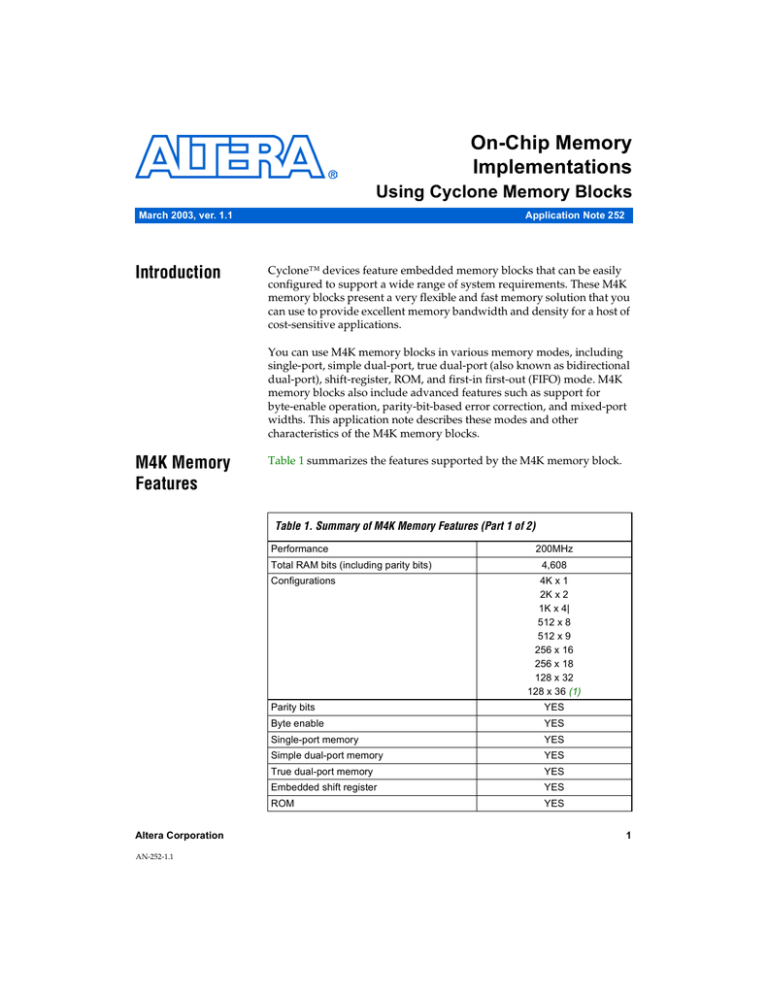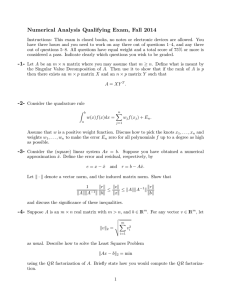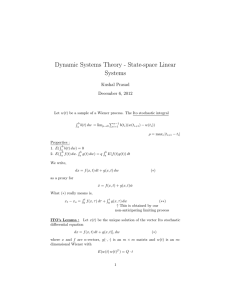
On-Chip Memory
Implementations
Using Cyclone Memory Blocks
March 2003, ver. 1.1
Introduction
Application Note 252
Cyclone™ devices feature embedded memory blocks that can be easily
configured to support a wide range of system requirements. These M4K
memory blocks present a very flexible and fast memory solution that you
can use to provide excellent memory bandwidth and density for a host of
cost-sensitive applications.
You can use M4K memory blocks in various memory modes, including
single-port, simple dual-port, true dual-port (also known as bidirectional
dual-port), shift-register, ROM, and first-in first-out (FIFO) mode. M4K
memory blocks also include advanced features such as support for
byte-enable operation, parity-bit-based error correction, and mixed-port
widths. This application note describes these modes and other
characteristics of the M4K memory blocks.
M4K Memory
Features
Table 1 summarizes the features supported by the M4K memory block.
Table 1. Summary of M4K Memory Features (Part 1 of 2)
Performance
Total RAM bits (including parity bits)
Configurations
Altera Corporation
AN-252-1.1
200MHz
4,608
4K x 1
2K x 2
1K x 4|
512 x 8
512 x 9
256 x 16
256 x 18
128 x 32
128 x 36 (1)
Parity bits
YES
Byte enable
YES
Single-port memory
YES
Simple dual-port memory
YES
True dual-port memory
YES
Embedded shift register
YES
ROM
YES
1
AN 252: On-Chip Memory Implementations Using Cyclone Memory Blocks
Table 1. Summary of M4K Memory Features (Part 2 of 2)
FIFO buffer
YES
Simple dual-port mixed width support
YES
True dual-port mixed width support
YES
Memory initialization (.mif)
YES
Mixed-clock mode
YES
Power-up condition
Outputs cleared
Register clears
Input and output registers (2)
Same-port read-during-write
New data available at positive
clock edge
Mixed-port read-during-write
Outputs set to unknown or old
data
Notes to Table 1:
(1)
(2)
®
®
The Altera Quartus II software will automatically cascade or concatenate
multiple M4K memory blocks to provide deeper or wider memory functions.
Asserting the clear port of the rden and byte-enable registers drives the output of
these registers high.
Table 2 shows the memory capacity for M4K memory blocks in each
Cyclone device.
Table 2. M4K Memory Distribution in Cyclone Devices
Device
Columns
Blocks
Total RAM Bits
EP1C3
1
13
59,904
EP1C4
1
17
78,336
EP1C6
1
20
92,160
EP1C12
2
52
239,616
EP1C20
2
64
294,912
Parity Bit Support
M4K memory blocks support an optional parity bit for each data byte. Of
the 4,608 bits of storage space available in an M4K block, 512 are available
for use as parity-bit storage. The parity bit, along with logic implemented
in logic elements (LEs), can facilitate parity-checking methods of error
detection to ensure data integrity. You can also use parity-size data words
to store user-specified control bits or as extra data bits to provide support
for 9-bit, 18-bit, or 36-bit wide memories.
2
Altera Corporation
AN 252: On-Chip Memory Implementations Using Cyclone Memory Blocks
Byte-Enable Support
Byte-enable signals can be used to mask the input data so that only
specific bytes in memory are overwritten. The unwritten bytes retain the
data value that was last written to them. The write-enable signal (wren) is
used in conjunction with byte-enable signals (byteena) to control the
M4K block’s write operations. The default value for the byteena signal is
high (enabled), in which case no bytes are masked and writing is
controlled only by the wren signals.
Asserting the clear port of the byte-enable register drives the byte-enable
signal to its default high level.
M4K blocks support byte write operations when the write port has a data
width of 16, 18, 32, or 36 bits. Table 3 summarizes how byteena controls
which bits are masked.
Table 3. Byte Enable for M4K Blocks
byteena
datain x18
Note (1), (2)
datain x36
[0] = 1
[8..0]
[8..0]
[1] = 1
[17..9]
[17..9]
[2] = 1
-
[26..18]
[3] = 1
-
[35..27]
Notes to Table 3:
(1)
(2)
Any combination of byte-enable signals is possible.
Byte enables can be used in the same manner with 8-bit words, i.e., in x16 and x32
modes.
Figure 1 shows how both the wren and the byteena signals control the
write operations of the RAM.
Altera Corporation
3
AN 252: On-Chip Memory Implementations Using Cyclone Memory Blocks
Figure 1. Byte-Enable Operation Functional Waveform
inclock
wren
a0
address
an
data_in
XXXX
byteena
XX
a1
a2
10
01
11
XX
ABFF
FFCD
FFFF
contents at a2
doutn
asynch_data_out
a2
XXXX
FFFF
contents at a1
a1
ABCD
FFFF
contents at a0
a0
ABXX
ABCD
XXCD
ABCD
ABFF
FFCD
ABCD
Power-up Conditions & Memory Initialization
Upon power-up, M4K memory is in an idle state. The outputs always
power-up to zero, regardless of whether the output registers are used or
bypassed. Even if a memory initialization file is used to pre-load the
contents of the RAM block, the outputs will still power-up cleared. For
example, if address 0 is pre-initialized to FF, the M4K blocks power-up
with the output at 00.
Using M4K
Memory
f
M4K memory blocks include input registers that synchronize write
operations and output registers to pipeline designs and improve system
performance. All M4K memory blocks are fully synchronous, meaning
that all inputs are registered, but outputs can be either registered or
combinatorial. M4K memory can emulate asynchronous memory.
For more information, see AN 210: Converting Memory from Asynchronous
to Synchronous for Stratix Designs.
M4K memory blocks can operate in various modes, including:
■
■
■
■
■
■
4
Single-port
Simple dual-port
True dual-port (bidirectional dual-port)
Shift-register
ROM
FIFO
Altera Corporation
AN 252: On-Chip Memory Implementations Using Cyclone Memory Blocks
Implementing Single-Port Mode
Single-port mode supports non-simultaneous read and write operations.
Figure 2 shows the single-port memory configuration for M4K blocks.
Figure 2. Single-Port Memory
data[ ]
address[ ]
wren
inclock
inclocken
inaclr
Note (1)
q[ ]
outclock
outclocken
outaclr
Note to Figure 2:
(1)
Two single-port memory blocks can be implemented in a single M4K block.
M4K memory blocks can also be divided in half and used for two
independent single-port RAM blocks. The Quartus II software
automatically uses this method of single-port memory packing when
running low on memory resources. When deliberately assigning two
single-port memories to one M4K block, first ensure that each of the two
independent RAM blocks is equal to or less than half the size of the M4K
block.
In the single-port RAM configuration, the outputs can only be in readduring-write mode, which means that during the write operation, data
written to the RAM flows through to the RAM outputs. When the output
registers are bypassed, the new data is available on the rising edge of the
same clock cycle on which it was written.
f
For more information about read-during-write mode, see “Read-duringWrite Operation at the Same Address” on page 20.
Figure 3 shows timing waveforms for read and write operations in singleport mode.
Altera Corporation
5
AN 252: On-Chip Memory Implementations Using Cyclone Memory Blocks
Figure 3. Single-Port Timing Waveforms
in clock
wren
address
an-1
an
data_in
din-1
din
synch_data_out
asynch_data_out
a0
din-2
din-1
a1
din
din
din-1
a2
dout0
dout0
dout1
a3
dout1
a4
a5
a6
din4
din5
din6
dout2
dout2
dout3
dout3
din4
din4
din5
Implementing Simple Dual-Port Mode
Simple dual-port memory supports simultaneous read and write
operations. Figure 4 shows the simple dual-port memory configuration
for M4K blocks.
Figure 4. Simple Dual-Port Memory
data[ ]
wraddress[ ]
wren
inclock
inclocken
inaclr
Note (1)
rdaddress[ ]
rden
q[ ]
outclock
outclocken
outaclr
Note to Figure 4:
(1)
Simple dual-port RAM supports read/write clock mode in addition to the
input/output clock mode shown.
M4K memory supports mixed-width configurations, allowing different
read and write port widths. This capability is useful for many
applications, including implementing serializer-deserializers (SERDES)
as well as interfacing with buses of differing widths. Table 4 shows the
mixed-width configurations supported by the M4K blocks in Cyclone
devices.
6
Altera Corporation
AN 252: On-Chip Memory Implementations Using Cyclone Memory Blocks
.
Table 4. M4K Block Mixed-Width Configurations (Simple Dual-Port Mode)
Read
Port
Write Port
4Kx1
2Kx2
1Kx4
512x8
256x16
128x32
512x9
256x18
128x36
4Kx1
v
v
v
v
v
v
2Kx2
v
v
v
v
v
v
1Kx4
v
v
v
v
v
v
512x8
v
v
v
v
v
v
256x16
v
v
v
v
v
v
128x32
v
v
v
v
v
v
512x9
v
v
v
256x18
v
v
v
128x36
v
v
v
In simple dual-port mode, M4K blocks have one write-enable and one
read-enable signal. On the M4K block, asserting the clear port of the rden
register drives rden high, which allows the read operation to occur. When
the read-enable signal is deactivated, the current data is retained at the
output ports. If the read-enable signal is activated during a write
operation with the same address location selected, the simple dual-port
RAM output is either unknown or can be set to output the old data stored
at the memory address.
f
For more information, see “Read-during-Write Operation at the Same
Address” on page 20.
Figure 5 shows timing waveforms for read and write operations in simple
dual-port mode.
Altera Corporation
7
AN 252: On-Chip Memory Implementations Using Cyclone Memory Blocks
Figure 5. Simple Dual-Port Timing Waveforms
wrclock
wren
wraddress
an-1
an
data_in
din-1
din
a0
a1
a2
a3
a4
a5
a6
din4
din5
din6
rdclock
rden
rdaddress
synch_data_out
asynch_data_out
bn
doutn-2
doutn-1
b1
b0
doutn-1
doutn
b2
b3
doutn
dout0
Implementing True Dual-Port Mode
M4K blocks offer a true dual-port mode to support any combination of
two-port operations: two read operations, two write operations, or one
read operation and one write operation at two different clock frequencies.
True dual-port memory can be used to increase memory bandwidth in
numerous applications. An example system that benefits from the use of
true dual-port memory is a system containing an Altera Nios® embedded
processor and a direct memory access (DMA) controller. Such a system
will experience bottlenecks if the processor and the DMA controller need
simultaneous access to single-port memory. The ability of both the
processor and the DMA controller to access the M4K memory
simultaneously, avoiding the need for arbitration, can dramatically
improve bandwidth in this type of system.
Figure 6 shows the true dual-port memory configuration for M4K blocks.
8
Altera Corporation
AN 252: On-Chip Memory Implementations Using Cyclone Memory Blocks
Figure 6. True Dual-Port Memory
Note (1)
A
B
dataA[ ]
addressA[ ]
wrenA
clockA
clockenA
qA[ ]
aclrA
dataB[ ]
addressB[ ]
wrenB
clockB
clockenB
qB[ ]
aclrB
Note to Figure 6:
(1)
True dual-port memory supports input/output clock mode in addition to the
independent clock mode shown.
The widest bit configuration of a single M4K block in true dual-port mode
is 256 x 16-bit (or 256 x 18-bit with parity). The 128 x 32-bit (128 x 36-bit
with parity) configuration of the M4K block is unavailable because the
number of output drivers is equivalent to the maximum bit width of the
M4K block. Because true dual-port RAM has outputs on two ports, the
maximum width of the true dual-port RAM equals half of the total
number of output drivers. However, multiple M4K blocks can be
concatenated to support wider memory configurations. Table 5 lists the
possible M4K RAM block configurations.
Table 5. M4K Block Mixed-Port Width Configurations (True Dual-Port Mode)
Port B
Port A
Altera Corporation
4Kx1
2Kx2
1Kx4
512x8
256x16
512x9
256x18
4Kx1
v
v
v
v
v
2Kx2
v
v
v
v
v
1Kx4
v
v
v
v
v
512x8
v
v
v
v
v
256x16
v
v
v
v
v
512x9
v
v
256x18
v
v
9
AN 252: On-Chip Memory Implementations Using Cyclone Memory Blocks
In true dual-port mode, the RAM outputs can only be configured for readduring-write mode. This means that during write operation, data being
written to the A or B port of the RAM flows through to the A or B outputs,
respectively. When the output registers are bypassed, the new data is
available on the rising edge of the same clock cycle it was written on.
f
For sample waveforms and other information on mixed-port read-duringwrite mode, see “Read-during-Write Operation at the Same Address” on
page 20.
Potential write conflicts must be resolved external to the RAM because
simultaneously writing to the same address location at both ports results
in unknown data storage at that location. For a valid write operation to the
same address of the RAM block, the rising edge of the write clock for port
A must occur following the minimum write cycle time interval after the
rising edge of the write clock for port B. Since data is written into the M4K
blocks at the falling edge of the write clock, the rising edge of the write
clock for port A should occur following half of the minimum write cycle
time interval after the falling edge of the write clock for port B. If this
timing is not met, the data stored in that particular address will be invalid.
f
See the Cyclone FPGA Family Data Sheet for more information about the
minimum synchronous write cycle time.
Figure 7 shows true dual-port timing waveforms for a write operation at
port A and a read operation at port B.
10
Altera Corporation
AN 252: On-Chip Memory Implementations Using Cyclone Memory Blocks
Figure 7. True Dual-Port Timing Waveforms
A_clk
A_wren
A_address
A_data_in
an-1
an
din-1
din
A_synch_data_out
din-2
A_asynch_data_out
a0
din
din-1
din
din-1
a1
a2
dout0
dout1
dout1
dout0
a3
a4
a5
a6
din4
din5
din6
dout2
dout2
dout3
dout3
din4
din5
din4
B_clk
B_wren
B_address
B_synch_data_out
B_asynch_data_out
bn
doutn-2
doutn-1
b1
b0
doutn-1
doutn
b2
dout0
doutn
dout0
b3
dout1
dout1
dout2
Implementing Shift-Register Mode
Embedded memory configurations can implement shift-register blocks
for digital signal processing (DSP) applications, such as finite impulse
response (FIR) filters, pseudo-random number generators, multi-channel
filtering, and auto-correlation and cross-correlation functions. These and
other DSP applications require local data storage, traditionally
implemented with standard flip-flops that can quickly consume many
logic cells for large shift registers. A more efficient alternative is to use
embedded memory as a shift-register block, which saves logic cell and
routing resources and provides a more efficient implementation.
The size of a (w x m x n) shift register is determined by the input data
width (w), the length of the taps (m), and the number of taps (n). The size
of a (w x m x n) shift register must be less than or equal to the 4,608 bits.
In addition, the size of (w x n) must be less than or equal to 36 bits. If a
larger shift register is required, memory blocks can be cascaded together.
Data is written into each address location at the falling edge of the clock
and read from the address at the rising edge of the clock. The shift-register
mode logic automatically controls the positive and negative edge clocking
to shift the data in one clock cycle. Figure 8 shows the M4K memory block
in shift-register mode.
Altera Corporation
11
AN 252: On-Chip Memory Implementations Using Cyclone Memory Blocks
Figure 8. M4K Shift-Register Memory Configuration
w × m × n Shift Register
m-Bit Shift Register
w
w
m-Bit Shift Register
w
w
n Number
of Taps
m-Bit Shift Register
w
w
m-Bit Shift Register
w
w
Implementing ROM Mode
M4K blocks can also be configured as ROM. ROM can be initialized in an
M4K block by using a memory initialization file (.mif). Because all M4K
memory configurations must have synchronous inputs, the address lines
of the ROM are registered. ROM outputs can be registered or
combinatorial. The read operation of the ROM is identical to the read
operation of the single-port RAM configuration.
Implementing FIFO Buffers
FIFO buffer outputs are always combinatorial. Simultaneous read and
write operations from an empty FIFO buffer are not supported.
12
Altera Corporation
AN 252: On-Chip Memory Implementations Using Cyclone Memory Blocks
Clock Modes
Depending on the M4K memory mode, independent, input/output,
read/write, and/or single-port clock modes are available. Table 6 shows
the clock modes supported by the M4K memory modes.
Table 6. M4K Memory Clock Modes
Clocking Mode
True-Dual Port
Mode
Independent
v
Input/output
v
Read/write
Single-port
Simple DualPort Mode
Single-Port
Mode
v
v
v
Independent Clock Mode
M4K memory blocks can implement independent clock mode for true
dual-port memory. In this mode, a separate clock is available for each port
(A and B). Clock A controls all registers on the port A side, while clock B
controls all registers on the port B side. Each port also supports
independent clock-enable signals and asynchronous clear signals for port
A and B registers. Figure 9 shows an M4K memory block in independent
clock mode.
Altera Corporation
13
14
clockA
clkenA
wrenA
addressA[ ]
byteenaA[ ]
dataA[ ]
8
ENA
D
ENA
D
ENA
D
ENA
D
8 LAB Row Clocks
Q
Q
Q
Q
Write
Pulse
Generator
ENA
D
Q
Data Out
Write/Read
Enable
Address A
qA[ ]
Data In
B
qB[ ]
Q
D
ENA
Data Out
Write/Read
Enable
Address B
Byte Enable B
Memory Block
256 ´ 16 (2)
512 ´ 8
1,024 ´ 4
2,048 ´ 2
4,096 ´ 1
Byte Enable A
Data In
A
Write
Pulse
Generator
Q
Q
Q
Q
ENA
D
ENA
D
ENA
D
ENA
D
8
clockB
clkenB
wrenB
addressB[ ]
byteenaB[ ]
dataB[ ]
AN 252: On-Chip Memory Implementations Using Cyclone Memory Blocks
Figure 9. Independent Clock Mode
Altera Corporation
AN 252: On-Chip Memory Implementations Using Cyclone Memory Blocks
Input/Output Clock Mode
M4K memory blocks can implement input/output clock mode for true
and simple dual-port memory. On each of the two ports, A and B, one
clock controls all registers for inputs (data input, wren, and address)
into the memory block. The other clock controls the block’s data output
registers. Each memory block port also supports independent clock
enables and asynchronous clear signals for input and output registers.
Figures 10 and 11 show the memory block in input/output clock mode for
true and simple dual-port modes, respectively.
Altera Corporation
15
16
clockA
clkenA
wrenA
addressA[ ]
byteenaA[ ]
dataA[ ]
8
ENA
D
ENA
D
ENA
D
ENA
D
8 LAB Row Clocks
Q
Q
Q
Q
Write
Pulse
Generator
Q
Data Out
Write/Read
Enable
Address A
ENA
D
A
qA[ ]
Data In
B
qB[ ]
Q
D
ENA
Data Out
Write/Read
Enable
Address B
Byte Enable B
Memory Block
256 × 16 (2)
512 × 8
1,024 × 4
2,048 × 2
4,096 × 1
Byte Enable A
Data In
Write
Pulse
Generator
Q
Q
Q
Q
ENA
D
ENA
D
ENA
D
ENA
D
8
clockB
clkenB
wrenB
addressB[ ]
byteenaB[ ]
dataB[ ]
AN 252: On-Chip Memory Implementations Using Cyclone Memory Blocks
Figure 10. Input/Output Clock Mode in True Dual-Port Mode
Altera Corporation
AN 252: On-Chip Memory Implementations Using Cyclone Memory Blocks
Figure 11. Input/Output Clock Mode in Simple Dual-Port Mode
Note (1)
8 LAB Row
Clocks
Memory Block
256 ´ 16
512 ´ 8
1,024 ´ 4
2,048 ´ 2
4,096 ´ 1
8
data[ ]
D
Q
ENA
Data In
address[ ]
D
Q
ENA
Read Address
Data Out
byteena[ ]
D
Q
ENA
Byte Enable
wraddress[ ]
D
Q
ENA
Write Address
D
Q
ENA
Read Enable
D
Q
ENA
To MultiTrack
Interconnect
rden
wren
outclken
D
Q
ENA
inclken
wrclock
Write
Pulse
Generator
Write Enable
rdclock
Note to Figure 11:
(1)
For more information on the MultiTrack™ interconnect, see the Cyclone FPGA
Family Data Sheet.
Read/Write Clock Mode
M4K memory blocks can implement read/write clock mode for simple
dual-port memory. This mode can use up to two clocks. The write clock
controls the block’s data inputs, wraddress, and wren. The read clock
controls the data output, rdaddress, and rden. The memory blocks
support independent clock enables for each clock and asynchronous clear
signals for the read- and write-side registers. Figure 12 shows a memory
block in read/write clock mode.
Altera Corporation
17
AN 252: On-Chip Memory Implementations Using Cyclone Memory Blocks
Figure 12. Read/Write Clock Mode in Simple Dual-Port Mode
8 LAB Row
Clocks
Memory Block
256 × 16
512 × 8
1,024 × 4
Data In
2,048 × 2
4,096 × 1
8
data[ ]
Note (1)
D
Q
ENA
Data Out
address[ ]
D
Q
ENA
Read Address
wraddress[ ]
D
Q
ENA
Write Address
byteena[ ]
D
Q
ENA
Byte Enable
D
Q
ENA
Read Enable
To MultiTrack
Interconnect
D
Q
ENA
rden
wren
outclken
inclken
D
Q
ENA
wrclock
Write
Pulse
Generator
Write Enable
rdclock
Note to Figure 12:
(1)
For more information on the MultiTrack interconnect, see the Cyclone FPGA Family Data Sheet.
Single-Port Mode
The M4K memory blocks can implement single-port clock mode when
simultaneous read and write operations are not required (see Figure 13).
A single block in a memory block can support up to two single-port mode
RAM blocks in M4K blocks.
18
Altera Corporation
AN 252: On-Chip Memory Implementations Using Cyclone Memory Blocks
Figure 13. Single-Port Mode
Note (1)
8 LAB Row
Clocks
RAM/ROM
256 × 16
512 × 8
1,024 × 4
Data In
2,048 × 2
4,096 × 1
8
data[ ]
D
Q
ENA
Data Out
address[ ]
D
Q
ENA
Address
D
Q
ENA
To MultiTrack
Interconnect
wren
Write Enable
outclken
inclken
inclock
D
Q
ENA
Write
Pulse
Generator
outclock
Note to Figure 13:
(1)
For more information on the MultiTrack interconnect, see the Cyclone FPGA Family Data Sheet.
Synchronous &
PseudoAsynchronous
Modes
The M4K memory architecture implements synchronous, pipelined RAM
by registering both the input and output signals to the RAM block. All
M4K memory inputs are registered, providing synchronous write cycles.
In synchronous operation, an M4K block generates its own self-timed
strobe write enable (wren) signal derived from the global or regional
clock. In contrast, a circuit using asynchronous RAM must generate the
RAM wren signal while ensuring its data and address signals meet setup
and hold time specifications relative to the wren signal. The output
registers can be bypassed.
In an asynchronous memory, neither the input nor the output is
registered. While Cyclone devices do not support asynchronous memory,
they do support a pseudo-asynchronous read operation where the output
data is available during the same clock cycle as when the read address is
driven into it. Pseudo-asynchronous reading is possible in the simple and
true dual-port modes of the M4K blocks by clocking the read enable and
read address registers on the negative clock edge and bypassing the
output registers.
Altera Corporation
19
AN 252: On-Chip Memory Implementations Using Cyclone Memory Blocks
f
Read-duringWrite
Operation at
the Same
Address
For more information, see AN 210: Converting Memory from Asynchronous
to Synchronous for Stratix Designs.
The following two sections describe the functionality of the various M4K
memory configurations when reading from an address during a write
operation at that same address. There are two types of read-during-write
operations: same-port and mixed-port. Figure 14 illustrates the difference
in data flow between same-port and mixed-port read-during-write.
Figure 14. Read-during-Write Data Flow
Port A
data in
Port B
data in
Mixed-port
data flow
Same-port
data flow
Port A
data out
Port B
data out
Same-Port Read-during-Write Mode
For read-during-write operation of a single-port RAM or the same port of
a true dual-port RAM, the new data is available on the rising edge of the
same clock cycle it was written on. See Figure 15 for a sample functional
waveform.
When using byte-enable signals in true dual-port RAM mode, the outputs
for the masked bytes on the same port are unknown. (See Figure 1.) The
non-masked bytes are read out as shown in Figure 15.
20
Altera Corporation
AN 252: On-Chip Memory Implementations Using Cyclone Memory Blocks
Figure 15. Same-Port Read-during-Write Functionality
Note (1)
inclock
data_in
A
B
wren
data_out Old
A
Note to Figure 15:
(1)
Outputs are not registered.
Mixed-Port Read-during-Write Mode
This mode is used when a RAM in simple or true dual-port mode has one
port reading and the other port writing to the same address location with
the same clock. You can configure the M4K memory block to operate in
this mode and modify the parameter shown below using the
MegaWizard® Plug-In Manager included with the Quartus II software.
The READ_DURING_WRITE_MODE_MIXED_PORTS parameter for
M4K memory blocks determines whether or not to output the old data at
the address. Setting this parameter to OLD_DATA outputs the old data at
that address. Setting this parameter to DONT_CARE outputs an
unknown value. During the instantiation of an ALTSYNCRAM or
LPM_RAM_DP+ storage megafunction using the Quartus II software, the
MegaWizard plug-in manager asks “How should the q output behave
when reading a memory location that is being written from the other
port?” Clicking “I don’t care” assigns the DONT_CARE value to the
parameter, and clicking “Old memory contents appear” assigns the
OLD_DATA value to the parameter.
1
Altera recommends using the MegaWizard Plug-In Manager to
create these memory megafunctions rather than directly creating
instances. Once a storage megafunction is created using the
MegaWizard Plug-In Manager, use the MegaWizard Plug-In
Manager to make any necessary changes.
See Figure 16 and Figure 17 for sample functional waveforms showing
mixed-port read-during-write mode operation. These figures assume that
the outputs are not registered.
Altera Corporation
21
AN 252: On-Chip Memory Implementations Using Cyclone Memory Blocks
Figure 16. Mixed-Port Read-during-Write: OLD_DATA
inclock
addressA and
addressB
Port A
data_in
Address Q
A
B
Port A
wren
Port B
wren
Port B
data_out
Old
A
B
Figure 17. Mixed-Port Read-during-Write: DONT_CARE
inclock
addressA and
addressB
Port A
data_in
Address Q
A
B
Port A
wren
Port B
wren
Port B
data_out
Unknown
B
When two different clocks are used in dual-port RAM, the read-duringwrite behavior depends on the relationship of the clocks. The writing of
the new contents starts at the falling edge of the write clock. Therefore, if
the read clock’s rising edge occurs before the falling edge of the write
clock, the old data is read out. If the read clock’s rising edge occurs
between the falling edge of the write clock and half the minimum write
cycle time interval, the output is unknown data.
f
22
For the minimum synchronous-write-cycle time see the Cyclone FPGA
Family Data Sheet.
Altera Corporation
AN 252: On-Chip Memory Implementations Using Cyclone Memory Blocks
Conclusion
M4K memory blocks are a flexible memory solution available in Cyclone
devices that provide advanced features such as byte-enable capability,
parity bit storage capability, and shift-register mode, as well as mixedport width support and true dual-port mode. This flexibility makes these
embedded memory blocks well suited for a wide range of applications
including ATM cell packet processing, header/cell storage, channelized
functions, and program memory for processors.
Revision
History
Version 1.1
The following changes were made in Application Note 252 On-Chip
Memory Implementations Using Cyclone Memory Blocks:
■
101 Innovation Drive
San Jose, CA 95134
(408) 544-7000
http://www.altera.com
Applications Hotline:
(800) 800-EPLD
Literature Services:
lit_req@altera.com
23
Revised Table 2 with EP1C4.
Copyright © 2003 Altera Corporation. All rights reserved. Altera, The Programmable Solutions Company, the
stylized Altera logo, specific device designations, and all other words and logos that are identified as
trademarks and/or service marks are, unless noted otherwise, the trademarks and service marks of Altera
Corporation in the U.S. and other countries. All other product or service names are the property of their
respective holders. Altera products are protected under numerous U.S. and foreign patents and pending
applications, maskwork rights, and copyrights. Altera warrants performance of its
semiconductor products to current specifications in accordance with Altera's standard
warranty, but reserves the right to make changes to any products and services at any time
without notice. Altera assumes no responsibility or liability arising out of the application
or use of any information, product, or service described herein except as expressly agreed
to in writing by Altera Corporation. Altera customers are advised to obtain the latest
version of device specifications before relying on any published information and before
placing orders for products or services.
Altera Corporation






